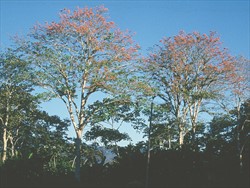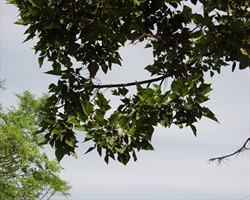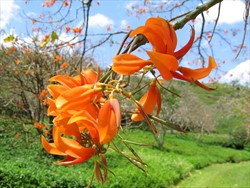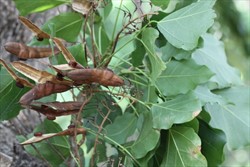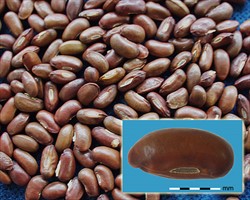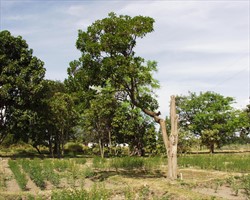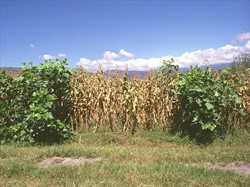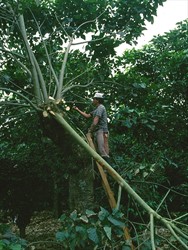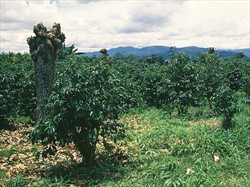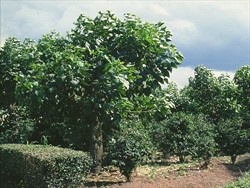Tropical Forages
Basionym: Micropteryx poeppigiana Walp.; Erythrina micropteryx Poepp. ex Urb.
Family: Fabaceae (alt. Leguminosae) subfamily: Faboideae tribe: Phaseoleae.
A large tree with a moderately spreading crown rising from a long branchless bole. Evergreen in humid tropical environments, but becoming fully or partially deciduous in seasonally dry environments. Up to 25 m (occasionally 35 m) in height and 2 m in diameter. Bark is greyish-brown to grey-brown, of variable roughness from smooth to slightly furrowed, with conical thorns on the branches and young twigs. Leaves are alternate, trifoliolate, 15‒30 cm long; leaflets rhomboid-oval or oval in shape, generally larger in saplings than in big trees; two prominent cup-shaped, nectar-producing glands below the paired lateral leaflets. Flowers produced in orange or reddish racemes with rachis 7‒40 cm long; 5 petals and 10 brown stamens per flower; upper petal wide and open. Pods 12‒25 cm long, falcate, slightly depressed between seeds, pointed at both ends, with a long peduncle; seeds ellipsoid to slightly curved, 10‒20 mm long × 5-7 mm broad, brown. 3,500‒6,500 seeds per kg.
Asia: dadap (Indonesia)
English: Coral tree, mountain immortelle, immortelle-tree
French: bois immortelle
Latin America: eritrina-do-alto, sinã (Brazil); amapola de sombra, amasisa, barbatusco, brucayo, bucare, búcare, bucaro, bucayo, bucayo gigante, cachimbo, cámbulo, ceibo, elequeme, gallito, helequeme, immortelle, palo de boya, poró desombra, poró extranjero, poró gigante, saibo (Spanish)
Native:
Central America: Panama (Darien)
South America: Bolivia (Beni, La Paz); Brazil (Acre); Colombia (Boyacá, Cundinamarca, Putumayo, Santander, Valle); Ecuador (Esmeraldas, Loja, Los Rios, Morona-Santiago, Napo, Pastaza, Pichincha, Sucumbios), Peru (Cuzco, Huanuco, Pasco, San Martin); Venezuela
Cultivated:
Widely cultivated.
Forage
Foliage is used as a ruminant feed.
Environment
Primarily used to provide shade and nutrient-rich prunings or leaf-fall in tropical plantation crop systems (e.g. cocoa, coffee, pepper). Soil improvement via mulch.
Other
Has potential in alley cropping systems as an N-rich hedgerow species. Used as living fence posts and occasionally as a low-quality fuelwood.
Occurs in the riverine and upland forests of the Amazon and Orinoco basins, and in the moist Pacific forests of Ecuador and Colombia, in humid and subhumid tropical lowlands receiving 1,000‒4,000 mm annual rainfall.
Soil requirements
Tolerates low soil fertility; acid-soil tolerance (to pH 4.3) varies with provenance. Adapted to soil texture varying from heavy clays to medium loam and even coarse sands. Tolerant of moderate soil alkalinity to pH 7.5. Intolerant of saline soils.
Moisture
Adapted to humid and subhumid regions with mean annual rainfall from 800 to 2,000 mm, occasionally to 4,000 mm. Tolerant of temporary waterlogging; can be used to drain very wet soils.
Temperature
Grows at low to mid-elevations (to 1,200 m asl) in its native range, but has naturalized to 2,000 m asl in exotic locations. Average annual temperatures in these regions range from 22 to 24 ºC, but will tolerate absolute maximum and minimum temperatures of 36 and 16 ºC, respectively. Top growth is killed by frost.
Light
Prefers full sun, but will tolerate light shade.
Reproductive development
Pollinated by perching passerine birds. Leaf-fall occurs mostly in combination with subsequent flowering; the severity of leaf-fall is proportional to the length and severity of the dry season. Under humid conditions, leaf-fall is visible but not severe.
Defoliation
Tolerant of severe, regular pruning; pruned trees are usually kept at 2‒2.5 m height. For highest production, defoliate a maximum of twice a year leaving 10‒25% of leaf area intact to facilitate regrowth. Survives complete pruning twice a year but will be killed by more frequent pruning. Complete mortality of N-fixing nodules occurs with heavy defoliation and re-establishment of nodules does not occur until 6 weeks after pruning.
Fire
Resistant to fire.
Guidelines for establishment and management of sown forages.
Establishment
Easily propagated from stem cuttings 0.5‒1.0 (2‒2.5) m in length, from branches at least 2 years old, from trees 5‒8 years old. Animals will damage stem cuttings and must be excluded until an extensive root system has developed. Can also be planted from seedlings or direct planted into the field from seed. Seedlings establish rapidly but weeds should be controlled during the first year of growth to ensure rapid establishment. As a shade and mulch tree in coffee plantations, should be planted at 6 × 6 m spacing if pruned twice annually, and at 12 × 12 m spacings if unpruned.
Fertilizer
Not generally fertilised when planted as a forage. Relies on fertilizer applied to plantation crops (e.g. coffee) when planted as a shade tree. Up to 60 kg of atmospheric N/ha can be fixed per year.
Compatibility (with other species)
Not generally used as a component of a direct-grazed pasture. Has been grown experimentally in hedgerows with sward-forming grasses (e.g. Brachiaria decumbens) in the inter-row. Suitable for growing in association with King grass (Cenchrus purpureus × C. americanus) and Cynodon nlemfuensis.
Companion species
Used as a shade and mulch crop over coffee. Planted as a hedgerow in maize ( Zea mays) and bean (Phaseolus vulgaris) alley farming.
Pests and diseases
A range of fungal diseases attack including leaf spots (Cercospora, Phyllosticta and Colletotrichum spp.), wilts (Verticillium spp.) and black mildew (Meliola spp.). It is affected by root knot nematodes (Meloidogyne spp.). is a host for June beetles (Phyllophaga menetriesi) which lay eggs on young leaves. The larvae subsequently feed on the roots of associated crops including maize, although the damage is reported to be minor.
Ability to spread
Will not spread under grazing.
Weed potential
None reported in the literature. Related species are also of low weed potential.
Nutritive value
Leaves contain 20‒22% DM and 22‒34% crude protein. IVDMD ranges from 49 to 58%. Young leaves can have much higher CP content (up to 38%) and IVDMD (up to 74%).
Palatability/acceptability
Well accepted by cattle and pen-fed goats, even as the sole feed.
Toxicity
The seeds, bark and roots contain curare-like alkaloids such as erysodine, erysopine, erysothiovine, erysovine and hypaphorine and can be ground to produce insecticides and a preparation to stun fish so that they can be easily caught. Leaves are also reported to contain toxic alkaloids but no adverse effects have been reported for cattle or goats consuming the foliage.
Feedipedia link
Dry matter
In Costa Rica, DM yields of up to 20 t/ha/year of leaf and branches have been produced yielding a total of 450 kg of N, but yields of 10 t/ha/year are more common. Planting density has little influence on DM yield at densities from 1,500 to 4,000 trees/ha as individual trees at low densities grow larger. Very high densities (60,000 trees/ha) will reduce forage yields. The productivity and quality of King grass ( × C. americanus hybrid) was assessed alone and in a mixture with in Costa Rica. At a density of 3,333 plants/ha of and with 3 cuts/year the mixture produced 31 t DM/ha/year and 2.82 t CP/ha. Lower plant densities and more frequent cutting reduced yields. The grass alone produced only 22 t DM/ha and 1.03 t CP/ha.
Animal production
In Costa Rica, goats supplemented with produced 1.26 kg milk/day, compared with 1.11 kg/day for those supplemented with Gliricidia sepium. In a related study no improvements in the productivity of cattle supplemented with were reported, but higher economic returns were achieved. Also in Costa Rica, crossbred dairy cattle consuming a basal diet of low quality grass hay, rice bran and molasses supplemented with produced 7.3 kg milk/day, compared with 6.7 kg/day for those supplemented with urea. Lambs gained 74‒128 g/day when fed at 3.5% of live weight. This range of weight gains accounts for other supplements added. Milk production in humid tropical Costa Rica was 10.5 kg/day when a basal diet of grass was supplemented with soya flour, 11.0 kg/day with fish flour supplement, 9.6 kg/day with supplement, and 9.3 kg/day with urea supplement. Economic net benefit was the highest using the supplement.
2n = 42. Feasibility of intercrossing with other Erythrina species resulting in fertile hybrids is reported.
Pruning trees once a year will impede flowering. No information regarding seed yields is available.
No information available.
- Easy to propagate from seeds or stem cuttings.
- High N content of leaf makes excellent mulch (natural litter fall).
- Tolerant of high water table.
- Seed, bark and roots contain toxic alkaloids.
- Brittle branches and superficial root system make exposed trees sensitive to wind damage.
Benavides, J. (ed). (1994) Arboles y Arbustos Forrajeros en América Central. Centro Agronómico Tropical de Investigación y Enseñanza (CATIE), Turrialba, Costa Rica.
Fassbender, H.W., Beer, J., Heuveldop, J., Imbach, A., Enriquez, G. and Bonneman, A. (1991) Ten year balances of organic matter and nutrients in agroforestry systems at CATIE, Costa Rica. Forest Ecology and Management 45:173–183. doi.org/10.1016/0378-1127(91)90215-H
Kass, D.L. (1994) Erythrina species - Pantropical multipurpose tree legumes. In: Gutteridge, R.C. and Shelton, H.M. (eds) Forage Tree Legumes in Tropical Agriculture. CAB International, Wallingford, Oxon, UK. p. 84–96. bit.ly/38LYfxV
Nygren, P. and Ramírez, C. (1995) Production and turnover of N2 fixing nodules in relation to foliage development in periodically pruned Erythrina poeppigiana (Leguminosae) trees. Forest Ecology and Management 73:59–73. doi.org/10.1016/0378-1127(94)03505-Q
Oyen, L.P.A. (1997). Erythrina poeppigiana (Walpers) O.F. Cook. In: Faridah Hanum, I. and van der Maesen, L.J.G. (eds) Plant Resources of South-East Asia No. 11. Auxiliary Plants. Backhuys Publishers, Leiden, the Netherlands. p. 123‒127. edepot.wur.nl/411331
Westley, S.B. and Powell, M.H. (eds). (1993) Erythrina in the New and Old Worlds. Nitrogen Fixing Tree Association Research Reports, Special Issue 1993. Winrock International, Morrilton, AR, USA.
None released.
None reported.
